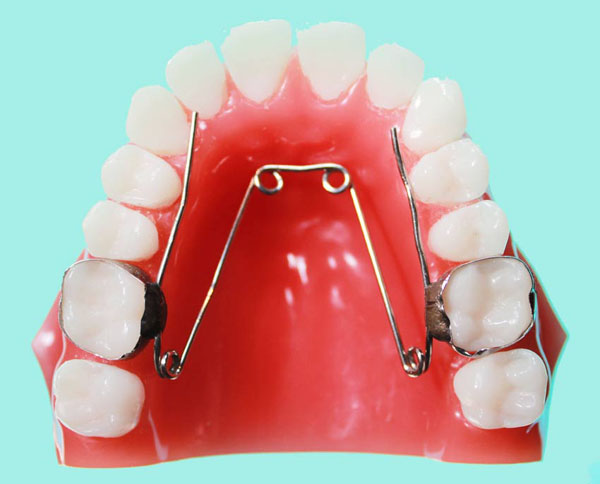Removable orthodontic appliances


Orthodontics — the dental specialty focused on correction and prevention of crooked teeth, spacing problems and malocclusion (bad bite) — often is necessary to improve the stability, function, health and esthetics of your smile. Orthodontic appliances, such as braces and retainers, straighten teeth and correct jaw alignment, as well as prevent or alleviate certain sleep-related complications.
Appliances are used during various stages of the orthodontic process, either to retain the new position of teeth, or in some cases to influence the growth of the jaws for a better bite alignment. Appliances may be fixed or removable.
Conditions Treated with Dental Appliances
Signs that you or your child may be a candidate for orthodontic appliances include the following:
- Improper jaw alignment (growth and habit disorders) causing teeth to meet abnormally or not at all, possibly causing TMD (temporomandibular joint disorders)
- Sleep disorders, such as snoring or obstructive sleep apnea
- Full mouth reconstruction and/or smile makeovers requiring stabilization
- Early or late loss of baby teeth, which can result in spacing problems, overcrowding, impacted and/or crooked teeth
- Finger sucking, tongue thrusting, lip wedging or other oral habits that can result in protruding teeth and unharmonious jaw growth
- Difficulty chewing or biting
- Breathing through the mouth
- Crowded, misplaced, protruding or blocked-out (possibly impacted) teeth
- Biting the inside of the cheek
- Facial imbalance or asymmetry
- Teeth grinding or clenching
Complications from Untreated Conditions
Protruding, crowded or irregularly spaced teeth create an unattractive appearance and can make oral hygiene difficult. Poor oral hygiene can lead to tooth decay, gum disease and tooth loss — in addition to a host of secondary health problems. An improper bite can interfere with chewing and speaking, cause abnormal wear to tooth enamel, and contribute to jaw problems such as TMJ. Other possible complications include earaches, headaches, migraines, neck and shoulder pains, and breathing and sleeping problems, such as snoring and lack of self-confidence.
Who Treats Patients with Orthodontic Appliances?
Most general dentists are trained to diagnose, examine and treat some minor orthodontic problems. However, if your general dentist determines your condition requires the skills of an orthodontic specialist, he or she will refer you to an orthodontist with two to three years of additional education beyond dental school.
Orthodontists are trained in the diagnosis, prevention and treatment of dental and facial irregularities, and regularly treat young children, teenagers and adults. Many orthodontists are trained to see children early (between age seven and nine) and to use “functional appliances” to help correct the facial, skeletal and dental disharmonies earlier so that braces are used for a shorter time, possibly avoiding later extractions or surgery. The facial profile is improved at an age when children are more malleable in both bone growth and cooperation factors.
Types of Orthodontic Appliances and Retainers
Examples of orthodontic appliances and retainers include the following:
- Elastics (Rubber Bands): Wearing elastics (or rubber bands) improves the fit of your upper and lower teeth. Wear rubber bands as instructed, and remember that the rubber bands work far more efficiently if they're worn as prescribed
- Forsus™: The Forsus Fatigue Resistant Device is an alternative to headgear which promotes growth in adolescents, helping to eliminate excessive overbites, improve the fit of teeth, and possibly prevent the need for jaw surgery
- Headgear: Headgear is used to treat patients whose teeth are in an overbite, with the upper jaw forward of the lower jaw, or an underbite with the lower jaw forward of the upper jaw. Headgear gently "pulls" on your teeth to restrict further forward growth of your upper teeth and jaw
- Herbst® Appliance: The Herbst® appliance reduces overbite by encouraging the lower jaw forward and the upper molars backward. This fixed appliance is used mostly for younger, growing children and is worn for about 12-15 months
- Palatal Expander: The palatal expander "expands" (or widens) your upper jaw by putting gentle pressure on your upper molars each time an adjustment is made. Your orthodontist will instruct you about when and how to adjust your expander. When you achieve the desired expansion, you will wear the appliance for several months to solidify the expansion and to prevent regression
- Positioners: Positioners complete the final tooth movements in your orthodontic treatment. With your full cooperation, you should only need to wear the positioner appliance for four to eight weeks
- Retainers: Retainers may be removable or fixed. They hold your teeth in their new, correct positions after your teeth have been straightened. Your orthodontist will instruct you on how to care for your retainer and about the duration of the wear. Wearing your retainer as directed is crucial to prevent regression of your treatment
- Separators or Spacers: Separators are little rubber doughnuts that may be placed between your teeth to push them apart so that orthodontic bands may be placed during your next appointment. The separators will be removed before we place the bands. Separators do not mix well with sticky foods, toothpicks, or floss
Patients Suitable for Orthodontic Appliances
If required, orthodontic treatment frequently starts around ages seven to 14. Ideal placement time is between ages 10 and 14, when the head and mouth are still growing and teeth are more adaptable to straightening.
The most common malocclusion treatments for children and adolescents are braces, retainers and space maintainers. Treatment with fixed braces usually lasts approximately 24 months with children and adolescents; approximately 28 months for adults. Some dentists recommend that retainers be worn for many years, since teeth naturally tend to drift out of place. Space maintainers keep the surrounding teeth from moving into open spaces when teeth are extracted or lost from trauma.
While early detection and correction during childhood and adolescence produces best results, adults still can correct problems such as crooked or crowded teeth, overbites, underbites, incorrect jaw position, or jaw-joint disorders through orthodontics. Since an adult's bones are harder and have stopped growing, adult treatment lasts longer than a child's treatment and may involve greater discomfort and expense and possible surgical procedures. Additionally, while orthodontic appliance treatment generally does not pose risks to adults with healthy teeth and gums, adults with gum disease are at higher risk. To avoid possible complications, such as further gum damage or tooth loss, adults with gum disease should get periodontal evaluations before starting orthodontic treatment
Length of Orthodontic Appliance Treatment
The length of time required for orthodontic appliances depends on the specific orthodontic condition and treatment plan. The more complex the spacing or bite problem, and the older the patient, the longer the treatment. Most patients wear full braces one to three years. Post-braces, most people typically wear some type of retainer for about a year to keep teeth in their new position; some may need to wear a retainer nightly for the rest of their lives.
Some types of orthodontic devices — like mouth guards, occlusal splints used during reconstructive oral procedures, or occlusal equilibration guards — are meant for limited-time wear under specific conditions, such as during physical activity/contact sports, oral surgery or occlusal equilibration, respectively. Wear time for sleep-related orthodontic appliances depends on the condition and severity of the sleep disorder.
Call our dental office today at (508) 720-5000 and schedule your complimentary orthodontic exam if you live in Arlington, Belmont, Cambridge, Lexington, Medford, Somerville, Waltham, Watertown, Winchester and Woburn.